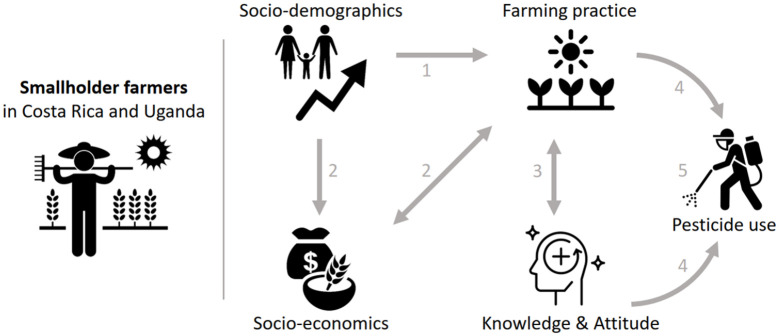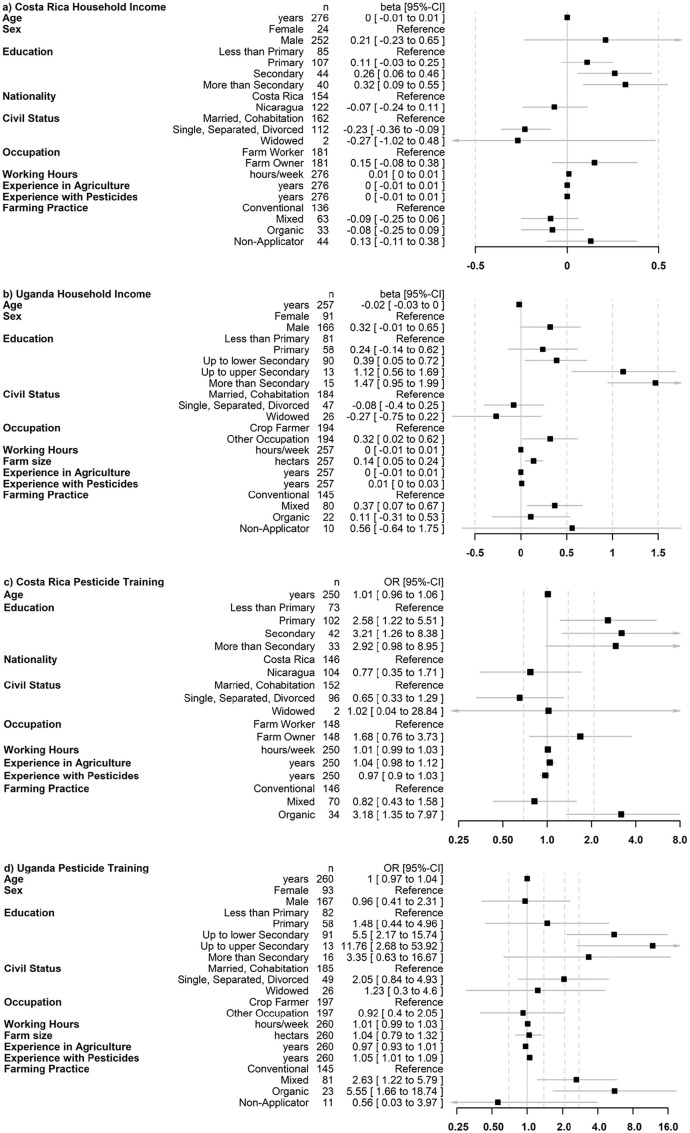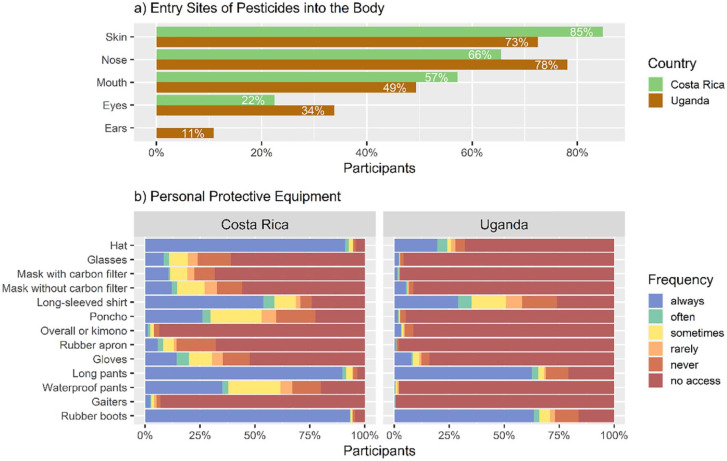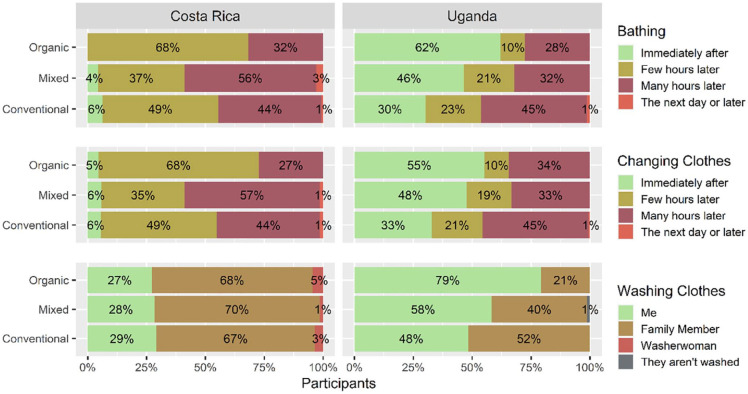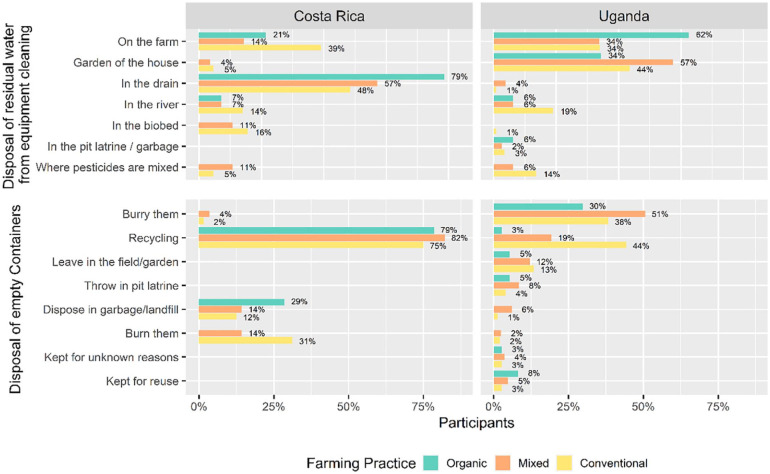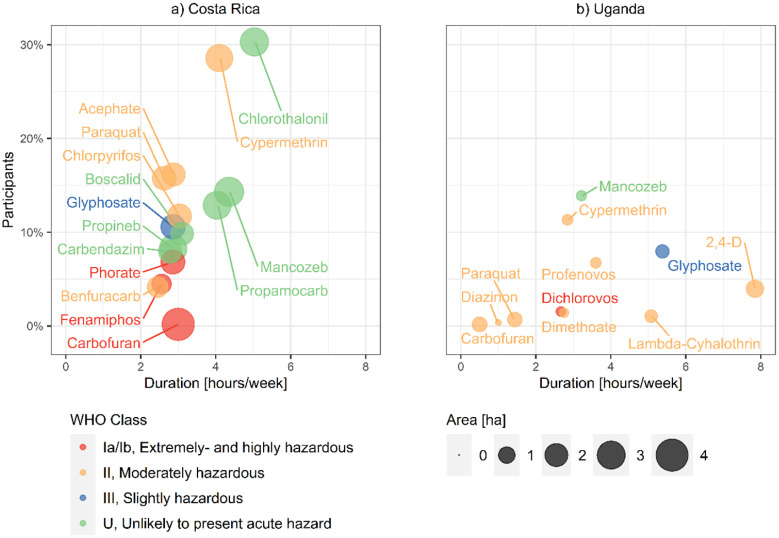Abstract
Pesticides are used globally in agriculture and pose a threat to the health of farmers, communities, and the environment. Smallholder farmers in low- and middle-income countries have generally a low socio-economic status and educational level. Consequently, they are particularly vulnerable to negative impacts of pesticides on their health, yields, or land. In a Knowledge, Attitude, and Practices study, we compared the pest management practices between a market-oriented farming system in Zarcero County, Costa Rica, and a subsistence-based farming system in Wakiso District, Uganda. We conducted a cross-sectional survey among smallholder farmers from Costa Rica (n = 300) in 2016 and from Uganda (n = 302) in 2017. We enrolled conventional and organic farmers, but also farmers with mixed practices and non-applicators of any pest management strategy. We found that the majority of pesticides used in both case studies are classified as highly hazardous by the World Health Organization. While more than 90% of smallholder farmers from both countries were aware of the negative health effects of pesticide exposure, <11% in Costa Rica and <2% in Uganda reported using personal protective equipment every time they handled or applied pesticides. Hygiene and other safe use practices were not adopted by all farmers (<61%), especially among farmers applying more hazardous pesticides. Conventional farmers from Costa Rica (14%) and Uganda (19%) reported disposing pesticide residuals into rivers. Using a logistic regression we found that organic farmers were more likely to having been trained on safe pesticide use practices. Using a robust regression, we observed that smallholder household income was primarily driven by education and not directly by the use of synthetic pesticides. Our results suggest that negative effects of pesticides can be managed over the whole life cycle, from purchase, via storage and application to residual and waste management by fostering professionalization of farmers. We advise future safe use and handling interventions to consider the pesticide use-related socioeconomic and demographic findings highlighted in this paper.
Keywords: Agriculture, highly-hazardous, pesticides, KAP, knowledge, attitude, practices, smallholder, farmer
Graphical Abstract
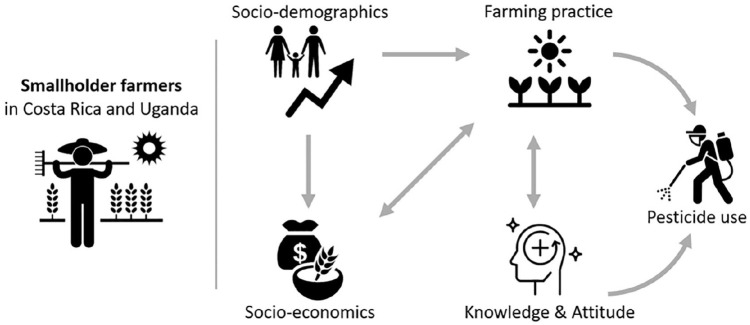
Introduction
Pesticides are important for crop production worldwide and their use increases together with economic growth.1 Among smallholder farms (farms with <2 ha),2 pesticides are the dominant form of pest management.3 These chemicals can have a negative impact on the environment4,5 and human health,6,7 particularly in low- and middle-income countries (LMICs)8,9 and when used unintentionally.10 LMICs often lack pesticide use regulations or implementation thereof, and have limited resources available to deal with the environmental and health consequences of pesticide use, such as access to a functioning health system or monitoring of water quality in open water bodies.11
The negative impact of pesticide use is affected, among other factors, by user knowledge and behaviors.12 Knowledge, Attitude, and Practice (KAP) surveys are used to describe situations within given contexts, in cross-sectional studies, and are commonly applied to compare changes over time13 KAP studies from LMICs have highlighted the extensive use of highly toxic pesticides coupled with low use of personal protective equipment (PPE),14 little awareness of exposure routes,15 occurrence of acute pesticide poisonings confirmed with biomarkers of effect (eg, acetylcholinesterase),16 inadequate disposal of pesticide residues and containers,17 and perception of pesticides as a simple solution.18 Furthermore, a KAP study that compared pesticide use and related health effects in more than 8500 smallholder farmers across 26 countries found that the majority of farmers were aware of the need for PPE, but often did not use them (eg, due to lack of availability).19,20 The same authors determined that there was a need for better disposal of used pesticide containers in most countries.19 In order to design effective mitigation strategies to the identified environmental and health effects associated with pesticide use, a thorough understanding of associated KAP in different cultural and socio-economic contexts is warranted.21
To that end, we designed an exploratory KAP study investigating pesticide use of smallholder farmers in contrasting cultural and economic situations. The study aimed at identifying commonalities and differences in pesticide use practices between market-oriented farms in Costa Rica and subsistence farming in Uganda. Costa Rica is an upper middle-income country with one of the highest rates of pesticide active ingredients (a.i.) applied (51.1 kg a.i. per hectare (kg/ha), whereas Uganda is a low-income country with one of the lowest application rates (0.01 kg/ha).22 Both study sites are located in tropical countries where farmers apply/handle similar pesticides with similar tools, while differing considerably in school life expectancy and gross domestic product per capita.23 To describe how access to resources and education influence safe pesticide use, we investigate the following 5 guiding research questions (Figure 1): First, how are socio-demographic characteristics associated with farming practices? Second, how are socio-demographic factors and farming practices associated with socio-economic factors? Third, how are farming practices associated with knowledge and attitude of safe pesticide use? Fourth, how are farming practices as well as knowledge and attitude associated with pesticide use practices? And fifth, how hazardous and which are the pesticides used?
Figure 1.
The framework links aspects of smallholder farmers’ livelihood around pesticide use. The numbers indicate the research questions. The framework is derived from our own thought process.
The ensemble of research questions forms an important piece of evidence of the Pesticide Use in Tropical Settings (PESTROP) project, which aimed to deepen the understanding of the environmental, health, and regulatory dimensions of agricultural pesticide use in tropical smallholder farming settings.24 The overarching project design and specific study components of the PESTROP project have been described elsewhere.25-28
Methods
Study areas and populations
This study included 2 different settings and study populations24 (i) the Tapezco river catchment area in Zarcero County, Costa Rica, which comprises commercial organic, sustainable (ie, mixture of organic and conventional farming practices), and conventional (ie, extensive use of synthetic pesticides) small-scale horticultural farms,27 (ii) the Mayanja river catchment area in Wakiso District, Uganda, which comprises subsistence-based horticultural farms whose practices range from no pest control to conventional farming.29
While the general study area characteristics were based on the intended comparison of contrasting cultural and socio-economic conditions for smallholder farming, the specific study locations were chosen such as to build on established contacts by the local partners to the respective farming communities. This ensured trust into the project team.
Study design and sample
An observational cross-sectional study design was applied. Two equal groups of organic (expected to not use synthetic pesticides) and conventional farmers (expected to use synthetic pesticides) were recruited, in order to ensure differences in KAP of pesticide use in both study settings. Organic farmers were recruited through snowball sampling from locally available farmer lists among NGOs. Conventional farmers were sampled randomly from clustered convenience samples. In Costa Rica, we used satellite imagery to locate arable plots and then visited the owners to determine their interest in participating in our study. In Uganda, we conducted an information event for village leaders, who then provided us with a list of interested farmers. In both countries, we enrolled a subsample of those interested in participating in the study. Participants were eligible if they were aged ⩾18 years and worked within the study areas. We aimed for a total sample of 300 farmers per country to detect a significant effect difference between 2 groups of 25 clusters (ie, 25 conventional and 25 organic farms with an average of 6 farmers each).27 During recruitment, we extended the possible clusters beyond organic and conventional farms to also include mixed farms (applying synthetic pesticides, but with evidence for the use of alternative pest management practices) and participants who were involved on farms, but not directly in pest management (henceforth called non-applicators, eg, land owners) (Table 1).
Table 1.
Term definitions as defined in this manuscript. Farmer-groups differ in self-conception by setting.
| Variable | Category | Definition | |
|---|---|---|---|
| Use of synthetic pesticides | Use of alternative pest management practices | ||
| Farming practice | Conventional | Yes | No |
| Organic | No | Yes | |
| Mixed | Yes | Yes | |
| Non-applicator | No | No | |
| Farmer-groups by setting | Farm owner (Costa-Rica) | Person who owns the farm, or the land or parts of it and, thus, is involved in sales and/or profits of the business. | |
| Farm worker (Costa-Rica) | Employee on the farm. | ||
| Crop farmer (Uganda) | Focusing on crops, as opposed to livestock, or exercising any other main non-farming profession. | ||
Data collection
Data collection was conducted between June and September 2016 in Costa Rica, and between September and November 2017 in Uganda. Over 2 weeks, field staff received training on tools, ethics, and research background. Additionally, we conducted a week-long pilot study in both settings. We administered a structured questionnaire to farmers using Open Data Kit (http://opendatakit.org). Details on data collected via questionnaire have been described elsewhere27 and can be found in the supplementary materials. Briefly, we collected information on socio-demographic characteristics including age, sex, education, marital status, and country of origin. Questions on socio-economic and occupational characteristics included years working in agriculture and handling/spraying pesticides, monthly household income, current job position or main profession, number of work hours per week, pesticide active ingredients used at the farm, average number of hours handling/spraying pesticides per week, farm size, crops cultivated at the farm, and distance between farm and water source. The knowledge, attitude and practices section covered pesticide safety-relevant daily behaviors such as bathing/showering, changing of clothes, clothes washing, disposal of residual water and empty pesticide containers, PPE use, and health risk perception. In Costa Rica, we conducted interviews in Spanish at the farmers’ workplace or home. In Uganda, we invited farmers to a rented office and interviewed them in Luganda or English. In order to account for variation in pesticide application, the results presented for “last week’s use” correspond to the average of application rates provided in 2 interviews that were conducted 3 to 4-week apart.
Statistical analyses and conventions
The 4 categories of farming practices were used to compare pesticide KAP within and between the 2 settings. We used analysis of variance (ANOVA) tests to determine whether socio-demographic characteristics between farmer groups differed significantly from each other. Two-group differences were calculated using chi-square statistics for categorical variables and t-tests for continuous variables. We used robust regression models (R robustbase package) to examine the relationship between logarithmic household income (outcome) and socio-demographic and farm characteristics (predictors). We fitted a logistic regression model to identify the predictors for having received training on pesticide use. The level of significance was assumed at 0.05. All analyses were carried out in STATA v 15.130 and R version 3.5.0.31 When referring to pesticide toxicity, we use both the “World Health Organization (WHO) Recommended Classification of Pesticides by Hazard”32 and the “Pesticide Action Network (PAN) International List of Highly Hazardous Pesticides.”33
Ethical considerations
All study materials were approved by the human subjects committee of the Universidad Nacional in Costa Rica (UNA-CECUNA-ACUE-04-2016), the Higher Degrees, Research and Ethics Committee (HDREC) of Makerere University in Uganda (HDREC 522), and Ethical Board of the Ethikkommission Nordwest- und Zentralschweiz in Switzerland (EKNZ-UBE 2016-00771). At enrollment, each participant gave written informed consent.
Results
Each subsection of the results chapter is addressing one of the guiding research questions. After the presentation of country-specific findings the most prominent differences between the study sites are highlighted in a comparative paragraph at the end of each subsection.
Socio-demographic characteristics classified by farming practices
Farmers in Costa Rica (N = 300) were 36.9 years old (SD 14.1) with 6.1 years of school (SD 2.8, Figure 2). They were mostly married (61.0%) and Costa Rican nationals (59%, Figure 3). We found several associations between socio-demographic characteristics and farming practices among Costa Rican farmers. There were fewer farm owners (vs. farm workers; 17.4%), more women (47.8%), and shorter work shifts (mean 42.7, SD 18.9 hours per week (h/wk)) among non-applicators than among all other farmer groups (ie, organic, mixed, and conventional; 41.3%, 2.0%, and mean 55.8, SD 16.0 h/wk in all 3 groups; Figures 2 and 3). We also found that Nicaraguan-born farmers had a lower educational level (mean 4.8, SD 3.0 years), worked more hours (mean 59.9, SD 15.0 h/wk) and were less likely to be a farm owner (4.9%) than Costa Rica-born farmers (mean 7.0, SD 2.4 years, mean 49.5, SD 17.2 h/wk, and 60.5% respectively).
Figure 2.
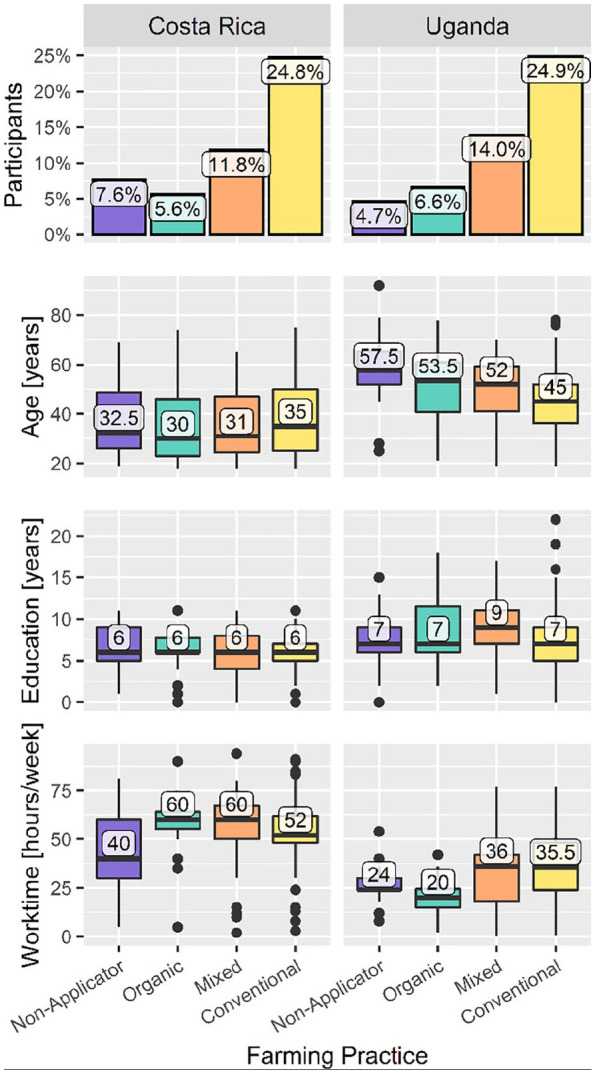
Socio-demographic characteristics per country and farmer classification. Working hours per week as average over the week before first and second visit.
Figure 3.
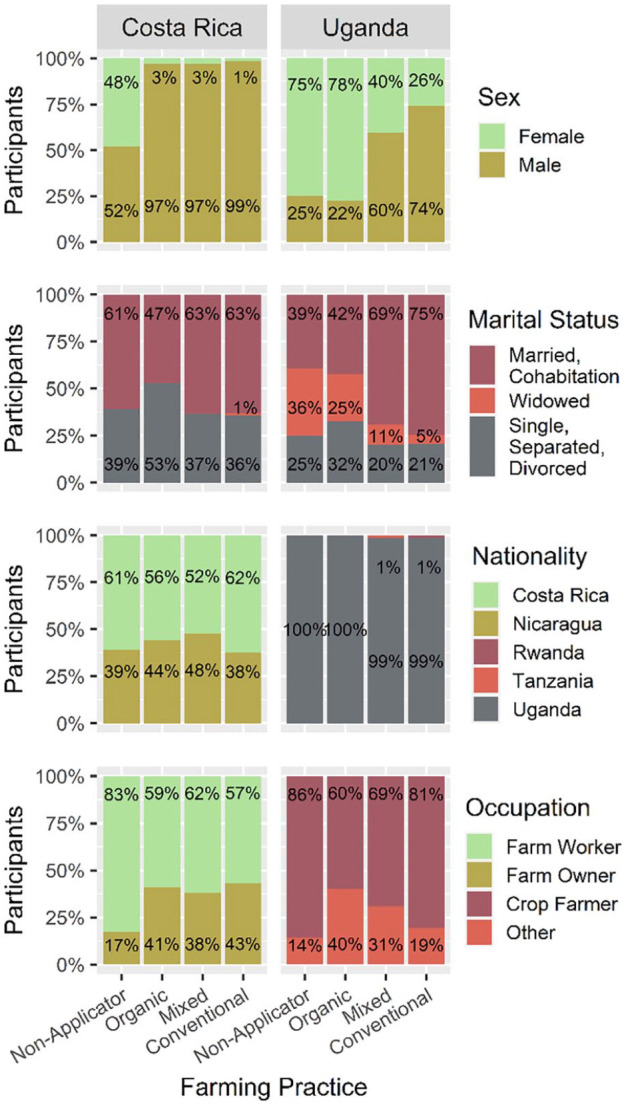
Socio-demographic characteristics per country and farmer classification. Nationality indicates nationality at birth, and occupation. Other indicates any profession besides crop farmer (see also Table 1).
Ugandan farmers (N = 302) were 48.0 years old (SD 13.6) with 8.0 years of school (SD 3.8, Figure 2). They were mostly married (65.6%) and Ugandan nationals (99%, Figure 3). We observed: (i) differences in education between users (organic and mixed farmers, mean 9.14, SD 3.7 years) and non-users (non-applicators, conventional farmers, mean 7.2, SD 3.6 years) of alternative pest management strategies (P < .001; Figure 2), (ii) a larger proportion of singles and widows among organic farmers (32.5% and 25.0%) and non-applicators (25.0% and 35.7%), in contrast with a larger proportion of married among mixed (69.0%) and conventional farmers (74.4%; Figure 3), (iii) a relatively low number (60.0%) of organic farmers reporting to farm crops as their main occupation (Figure 3), and (iv) a correspondingly lower amount of working-hours per week on the farm for organics (mean 20.9, SD 10.6 h/wk) vs. conventional (mean 35.3, SD 16.9 h/wk; Figure 2). Furthermore, conventional male farmers worked on average 36.9 h/wk (SD 17.5), while their organic male counterparts only worked 16.7 h/wk (SD 10.0; P < .001). A similar pattern was found for female farmers (conventional: 30.7 h/wk (SD 14.2), organic: 22.2 h/wk (SD 10.6, P < .004).
Costa Rican farmers were younger and had completed fewer years of education than their Ugandan peers. In both countries most farmers were married, and there were fewer women than men working in pest management. Among Costa Rican participants, we had 41% Nicaragua-born (migratory) farmers; whereas only 3 participants in Uganda were of other nationalities.
Farm description and household income
In Costa Rica, the crops grown were considerably different between conventional and mixed farmers (ie, potatoes, carrots, and coriander) and organic farmers (ie, tomatoes, bell peppers, and lettuce, Supplementary Figure SF1). Being more educated and working longer shifts were associated with a higher household income, whereas being single, separated, or divorced was associated with a lower household income (Figure 4). Conventional and mixed farms were closer to rivers compared to their organic and non-applying counterparts (Figure 5).
Figure 4.
(a) and (b) Forest plot with coefficients for multivariate robust regression of logarithmic household income and its predictors. (c) and (d) Forest plot with Odds Ratio for multivariate logistic regression of received pesticide training and its predictors. Univariate results can be found in Supplementary Figure SF2.
Figure 5.
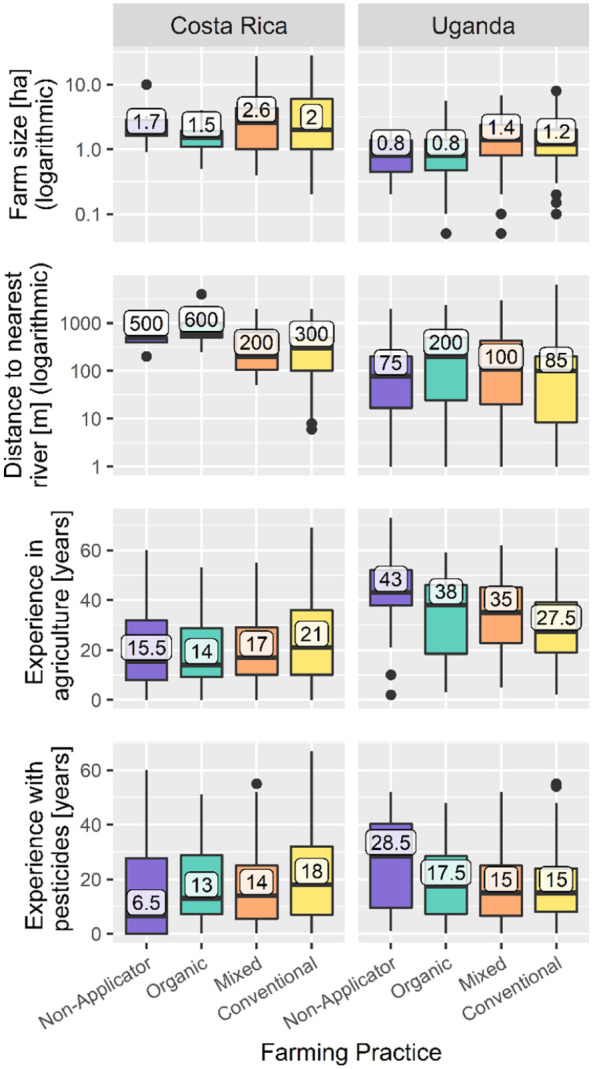
Socio-economic factors of individual farmers and their farms by country and farming practice.
In Uganda, the 4 most abundant crops (ie, beans, maize, (sweet) potato, bananas) were the same across all farming practices, albeit in different order. Bananas were most popular among mixed farmers (53.6%) compared to all other farmer groups (ie, organic, mixed, and conventional; 27.5%; Supplementary Figure SF1). Non-applicators had more years working in agriculture and handling/applying pesticides than farmers from other groups (Figure 5). Being more educated, not being a crop farmer as a main occupation, and using mixed farming practices were associated with a higher household income (Figure 4). Being male was also associated with a higher household income. Men received 112.7% more income compared to women (P < .001).
Studying the determinants of household income, we found associations with farming practice, farm size, education, occupation, working hours and civil status in either or both countries, with effect sizes being larger in Uganda than those in Costa Rica (Figure 4). In both study settings, mixed farms were the largest in size, while organic farms were the smallest and the furthest from water sources (Figure 5).
Determinants of pesticide use training
In Costa Rica, 48% of study participants had received pesticide use training from governmental institutions, agribusiness, and/or farm owners. More organic farmers (67.7%) and farm owners (66.7%), than conventional and mixed farmers (48.4% and 40.9%), or farm workers (35.6%) had received such a training. In the multivariate logistic regression model, the main predictors of whether a farmer had ever received pesticide training were being an organic farmer and being more educated (Figure 4).
In Uganda, only 22.9% of study participants had received training on pesticide use practices. Providers were primarily either Uganda National Association for Community and Occupational Health (28.0%) or other nongovernmental organizations (62.9%). In the regression model, the best predictors were the application of alternative pest management practices, being more educated, and having more years of experience handling/applying pesticides (Figure 4).
In both countries, the use of alternative pest management practices and having completed a secondary education were associated with having received training in safe pesticide use (Figure 4).
Health, hygiene, protection, and disposal of pesticides
In both countries, most farmers acknowledged that pesticides could affect their health (CR 97.7%; UG 90.4%) and identified dermal, inhalation, and ingestion as the main routes of pesticide exposure to the body (Figure 6a). In Uganda, in addition to the given options, a considerable number of participants (10.9%) explicitly stated “ears” as additional entry path. Notably, in Uganda, conventional and mixed farmers were significantly more aware of risks through inhalation (P = .007) and dermal exposure (P < .001) than organic farmers and non-applicators.
Figure 6.
(a) Pesticide entry sites into the body. Ears was not an answer option but explicitly mentioned in Uganda by 10.9% of participants. (b) Access and use of PPE.
In both countries, rubber boots, long pants, long-sleeved shirts, and hats were widely available and also worn by the farmers. There was, however, a clear between-country difference in access and use of more specific PPE. In Costa Rica, some farmers had access to masks with (32.4%) and without carbon filter (44.1%), glasses (39.3%), gloves (47.8%), rubber aprons (32.4%), and water proof pants (80.2%), but not all of them used them (eg, only 8.5% and 10.9% reported using masks with carbon filter or glasses always or often when applying pesticides, respectively; Figure 6b). In Uganda, farmers’ access to PPE was much more limited (eg, only 2.7% and 4.3% had access to masks with carbon filter and glasses, respectively [Figure 6b]).
In Costa Rica, none of the organic farmers reported bathing/showering immediately after applying homemade pesticides (ie, an alternative pest management practice) or the day after, but overall more organic farmers report bathing/showering or changing clothes within a few hours after applying homemade pesticides (68.2% and 72.2%), compared to mixed (both 41.2%) and conventional farmers applying synthetic pesticides (55.6% and 54.9%). In Uganda, most organic farmers reported bathing immediately after applying homemade pesticides (62.1%) rather than many hours later (27.6%, P < .001), whereas conventional farmers reported bathing many hours later (45.0%) rather than immediately (30.2%, P < .001) after applying synthetic pesticides. More organic farmers (79.3%) reported washing their own clothes compared to mixed (59.0%) and conventional farmers (48.3%, P < .001) (Figure 7).
Figure 7.
Hygiene practices in relation to pesticide application: Bathing and changing clothes after pesticide application and handling, responsible person washing clothes used during pesticide application and handling.
In both countries, across all farming practices, water used for cleaning pesticide application equipment was mainly disposed in the drain (CR 54.7%), directly in the garden (UG: 46.7%), or elsewhere on the farm directly onto soil (CR: 30.2%; UG: 37.5%) (Figure 8). Conventional farmers from both countries also reported disposing this residual water into rivers (CR: 11.3%; UG: 19.0%). In Costa Rica, a notable disposal route was the biobed (12.3%).
Figure 8.
Disposal of residual water from pesticide application equipment cleaning and disposal of empty pesticide containers.
Empty pesticide containers were either recycled (CR: 77.4%; UG: 32.0%), buried (UG: 42.5%), or burnt (CR: 22.6%; Figure 8). In Costa Rica, organic farmers did not burn any containers, but disposed all non-recycled containers in the garbage/landfill (28.6%). In Uganda, some conventional (13.4%) and mixed farmers (12.0%) left containers behind in their fields (Figure 8).
While being aware of health risks, farmers in both countries expressed low personal protective behaviors. Furthermore, pesticide residues and empty containers were disposed of into the environment.
Use of highly hazardous pesticides
In Costa Rica, the most commonly applied pesticide active ingredients during the twelve months prior to the study visit were the fungicide chlorothalonil, the herbicides paraquat and glyphosate, and the pyrethroid insecticide cypermethrin (Figure 9). About half of farmers reported using pesticides classified by WHO as Ia (extremely hazardous) and Ib (highly hazardous) during the twelve months prior to the study. Class II (moderately hazardous), III (slightly hazardous), and U (unlikely to present an acute hazard) pesticides were used by 69.7%, 58.3%, and 66.3% of farmers, respectively, in this same period. During the week prior to each study visit, the most commonly applied pesticides were chlorothalonil and cypermethrin. Together with mancozeb and propamocarb, they were also applied for longer periods of time (in h/wk) compared to other pesticides (Figure 10).
Figure 9.
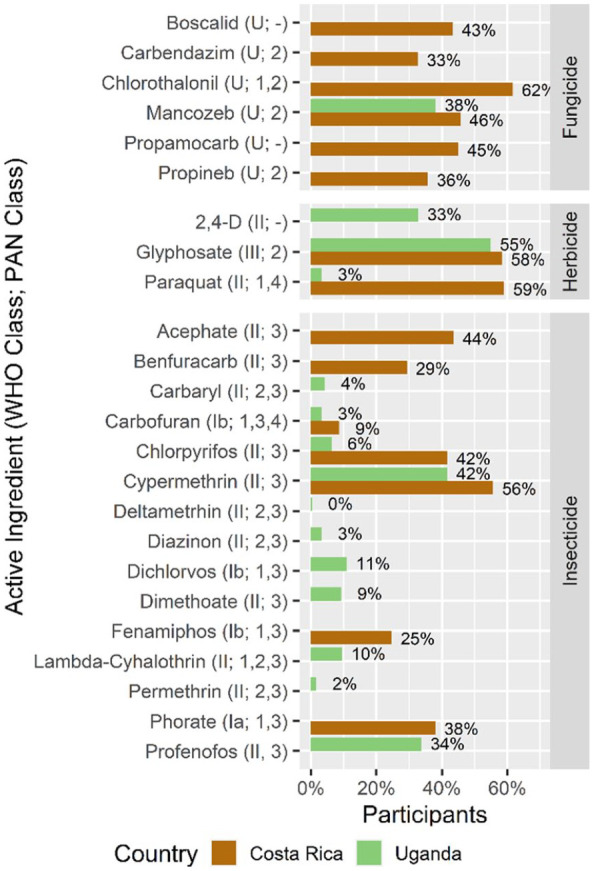
Proportion of participants using the listed active ingredients over the last 12 months. In parentheses first the World Health Organization recommended classification of pesticides by hazard (Ia, extremely hazardous; Ib, highly hazardous; II, moderately hazardous; III, slightly hazardous; U, unlikely to present acute hazard in normal use), followed by the Pesticide Action Network grouping for highly hazardous pesticides (1, acute toxicity; 2, long term effects; 3, environmental toxicity; 4, conventions).
Figure 10.
Y Axis: Share of participants applying the active ingredient; X Axis: Average exposure duration per active ingredient during the week prior to the 2 study visits; Bubble size: Average area of pesticides applied, in hectares; Color: WHO Toxicity classification.
In Uganda, the most commonly applied pesticide active ingredients during the twelve months prior to the study visit were the herbicide glyphosate, the insecticide cypermethrin, and the fungicide mancozeb. Besides these 3 chemicals, profenofos, and 2,4-D, all other pesticides were used by <11% of participants (Figure 9). During the week prior to the each visit, the most frequently applied pesticides were mancozeb and cypermethrin, but the ones applied for the longest periods of time were the herbicides 2,4-D and glyphosate, and the insecticide lambda-cyhalothrin (Figure 10). Most of pesticide active ingredients used by Ugandan farmers were WHO class II.
In both countries, most conventional and mixed farmers used highly hazardous pesticides (HHP) (CR: 93.2% UG: 91.9%) and class I or II pesticides (CR: 91.8%, UG: 80.3%) over the twelve months prior to the study visit. The active ingredients applied in Costa Rica were more diverse and applied by more farmers on larger areas compared to Uganda. In both countries, the most widely used active ingredients involved a fungicide, an herbicide, and an insecticide. Six active ingredients were used in both countries (Figure 9), 3 of which also ranked among the top 5 used pesticides in the country: mancozeb, glyphosate, and cypermethrin. Paraquat and chlorpyrifos were widely used in Costa Rica but rarely in Uganda, whereas carbofuran was seldom used in either setting.
Discussion
This study explores the commonalities and differences of the KAP of pesticide use among smallholder farmers between 2 tropical countries with unlike socio-economic and agronomic conditions. We found important similarities, but also substantial differences (Table 2). These descriptive findings form a basis to derive causal hypothesis regarding mechanisms explain the KAP of pesticide use.
Table 2.
Differences and similarities between the study sites in Costa Rica and Uganda for each of the five research questions.
| Topic | Costa Rica | Uganda |
|---|---|---|
| 1) How are socio-demographic characteristics associated with farming practices? | ||
| Participants were/had . . . | . . . younger, with fewer years of education, rarely women, and mostly married. | . . . older, with more years of education, about 2/5th women, and mostly married. |
| Migrant workers . . . | . . . made up 2/5th of participants, were less educated, worked longer shifts, and fewer were farm owners. | . . . were rare among participants. |
| Farming practices | Non-applicators worked shorter shifts, fewer were farm owners, and were comprised of equal proportions of men and women | Organic farmers were more educated, more likely to be women, single, and widowed, and 2/5th had a main occupation other than crop farmer |
| 2) How are socio-demographic factors and farming practices associated with socio-economic factors? | ||
| Household income was predicted by . . . | . . . more education, longer working hours, and civil status. | . . . more education, farm size, not being a crop farmer, and applying mixed farming practices. |
| Organic farms . . . | . . . were smallest in size and furthest from water in both countries. | |
| Major crops grown . . . | . . . differed between users and non-users of synthetic pesticides. | . . .were similar between practices. |
| 3) How are farming practices associated with knowledge and attitude of safe pesticide use? | ||
| Pesticide training . . . | . . . was common (1/2 of participants). | . . . was rare (1/5th of participants). |
| . . . was associated with more education and being an organic farmer. | . . . was associated with more education, being an organic farmer, and more years using pesticides. | |
| 4) How are farming practices as well as knowledge and attitude associated with pesticide use practices? | ||
| Health effects . . . | . . . and exposure routes were acknowledged and identified by most farmers in both countries. | |
| Regular PPE . . . | . . . was available and used in both countries. | |
| Specific PPE . . . | . . . was sometimes available but rarely used. | . . . was rarely available and used. |
| Hygiene behavior . . . | . . . was similar among all farmers. | Organic farmers had better hygiene behaviors and washed their clothes themselves. |
| Residual water . . . | . . . was disposed onto farm soil but also into rivers in both countries. | |
| Empty pesticide containers . . . | . . . were recycled or burnt. | . . . were recycled or buried. Some synthetic pesticide users left them behind in the field. |
| 5) How hazardous are the resulting pesticide use practices? | ||
| Toxicity | 90% used highly hazardous pesticides (HHP) and 80% used WHO class I/II in both countries. | |
| Most commonly used pesticides | Chlorothalonil (fungicide), glyphosate and paraquat (herbicides), cypermethrin (insecticide). | Mancozeb (fungicide), glyphosate and 2,4-D (herbicides), cypermethrin and profenofos (insecticides). |
Interventions need to address social inequalities
Differences in social characteristics between the 2 study populations were found for age and sex. When comparing median age above the participation limit of 18 years, we found that the Costa Rican participants were about 20% younger than the country median (32.5 years vs approx. 41 years), whereas the Ugandan group was about 60% older than the country median (49.0 years vs approx. 30 years).34 For Uganda, this age difference could be largely explained by 3 country-specific aspects: (i) our study site is close to the capital city Kampala, where young people flee from the countryside,35 (ii) land ownership or capital is held by the older population,36 and (iii) agriculture is perceived as backwards and not appealing by to the younger generation.37 This difference could also be explained by the fact that the age distribution in our study population in Uganda followed the shape of a constrictive pyramid, whereas the national distribution for the same period followed the shape of an expansive pyramid.38 Therefore, it is important to mention that all results described below have to be interpreted in the light of the demographic structure of our study populations.
Among Costa Rican farmers, we identified a minority of migrant farm workers with fewer years of education opposed by a majority of Costa Rican farm owners. The combination of lower education and limited access to and use of health services makes migrant farmworkers a vulnerable group.39,40 Thus, any interventions aiming to promote safer pesticide use practices should proactively involve vulnerable groups and address socio-cultural aspects.41,42
Farmers in Uganda who applied alternative pest management practices had more years of education than those who did not. This is akin to a study from China, where farmers with more years of education applied more non-chemical pest management techniques.43 Given an already higher knowledge level, the switch to alternative pest management comes with a change in attitudes as opposed to even more knowledge.44
Pesticides are considered unsafe for the health of (future) pregnant women.45 Therefore, it is no surprise that women enrolled in this study were most common among non-applicators (both countries) and organic farmers (Uganda). These findings contrast with those reported by Ochago 18 who found that women and elderly Ugandan smallholder coffee farmers did not consider the uptake of integrated pest management (IPM) practices attractive due to their increased labor requirements. Traditionally, both labor intensive work (ie, carrying a knapsack sprayer) and commercial crop production have been considered men’s tasks. Thus, it resonates that women would frequently avoid spraying synthetic pesticides in subsistence crops.
Pesticide use was not associated with farm household income
Reducing pesticide use is commonly seen to be a risk to income due to a possible loss in crop yield.46 However, our study showed that farming practices and thus use of synthetic pesticides was not the major driver of household income. Instead, the strongest predictor of household income was education, followed by occupations other than crop farming and longer work shifts, larger farms, and the application of mixed practices. More years of education leading to higher income is a well-known fact,47 but our study showed that other context-dependent factors played an important role in determining choice of farming practices and income from farming, which are discussed as follows: First, in Costa Rica, all farmers lived off their income from agricultural activities. In Uganda, on the other hand, 1 out of 4 participants had an occupation different than crop farmer. A common practice in Uganda is to have an occupation, such as teacher or hair dresser, and also have a garden at home, supplying the family with fresh vegetables.48 Such subsistence farming can decrease overall household spending while at the same time increasing income by selling surplus.49 Second, differences in farm size and distance to water were linked with farming practices. In Uganda, market-oriented farmers (usually practicing pesticide intensive horticulture) tend to have larger plots50 and farms near streams to be able to grow crops all year round. On the other hand, due to intense labor requirements and limited access to biological pesticides, organic farms tend to be relatively small. This is in agreement with our findings, where larger farms with mixed farming practices were associated with higher household income (ie, opportunity to purchase bigger plots closer to water sources or expensive pesticides), whereas organic farms remain the furthest from water and smallest in size. With farmers of younger ages and more years of education, Ugandan agricultural systems will soon experience a shift from traditional (organic-by-default) self-subsistence farming practices to more market-oriented and sustainable practices (similar to Costa Rica).51,52 This process can further be supported by fostering full land ownership over mere occupancy rights.53
Farmers were likely to reduce pesticide use after pesticide training
In both countries, less than half of the study participants had received pesticide training. Along with education, organic pest management and years of pesticide use were identified as predictors for having received training in pesticide use. This finding may be explained by experienced pesticide users stopping or reducing pesticide use (ie, becoming organic or mixed farmers) after having received specific training (ie, including learning about the risks of pesticide use), as it has previously been observed in Uganda.17 Alternatively trainers may have specifically targeted low- or non-users of pesticides to convince them to start using pesticides, provoking a lock-in, as seen in Cambodia by Flor, Maat, Hadi, Kumar and Castilla54
In Costa Rica, organic and mixed farmers (using alternative pest management practices) were younger than conventional and non-applicators, whereas in Uganda conventional and mixed farmers (using synthetic pesticides) were younger than organic and non-applicators. These differences can be explained by the different perceptions of organic agriculture. In Costa Rica, organic and sustainable agriculture are considered progressive choices, set up for export,55,56 hence younger farmers tend to choose this option. In Uganda, organic and sustainable agriculture are perceived as old farming practices and are mainly promoted by foreign-funded NGOs.37 Younger farmers are more likely to have access to information channels, such as smartphones and television.29 Promoting alternative pest management strategies in these channels, classically dominated by marketing for synthetic pesticides,57 could increase the share of organic and mixed farming in commercial agriculture.
Improvements on safe use are required
Most farmers in both countries reported that pesticides could have negative effects on health and correctly identified the 2 primary entry sites: skin (dermal) and nose (airways).58 These findings contradict those from earlier studies conducted in Costa Rica (ie, pesticide users were not aware of exposure routes and did not perceive spraying as hazardous)15 and Uganda (ie, pesticide users had poor knowledge about pesticide toxicity).59
Regular farmer’s clothing (ie, rubber boots, long pants, long-sleeved shirt, and hat) was available and in use in both countries, but access to specific PPE such as gloves and waterproof pants was higher in Costa Rica than in Uganda. Factors explaining this higher use of specific PPE may be higher income and larger farm size.60 PPE for airways and eyes (ie, masks with carbon filters and glasses) were only used by a small fraction of farmers in both countries. These findings are consistent with those of previous studies.14,59,61,62 This is concerning because, even though PPE effectiveness under practical application is questioned,63,64 Cataño, Carranza, Huamaní and Hernández65 showed that farmers using PPE while spraying were less likely to experience pesticide poisoning.
Residues from washing application equipment were disposed of in the surroundings of the farm. In both countries, more than ten percent of conventional farmers also reported pouring pesticide residues into nearby rivers, thereby directly affecting the aquatic environment, leading to loss of biological integrity.66 Indeed, pesticide pollution of the waterbodies was observed in both study areas, at particularly high concentration levels in Costa Rica.24,67
While a large proportion of empty pesticide containers in both countries are recycled, it remains unclear what recycled means in each case. Recycling can mean “bringing back empty containers to the dealership,” or it can also indicate “reusing the containers for other purposes.” Either way, analyses of used containers have shown that regular triple rinsing options are insufficient for decontamination of containers, implying that any kind of reuse or recycling in a low resource setting is inappropriate.68 To reduce the environmental footprint of pesticide use, it is important to look beyond the application of the chemicals, and improve the residue and waste management conducted by the farmer, like equipment cleaning and container disposal, without forgetting to reduce the pesticides introduced into the environment through spraying, drift, and runoff.69
Upstream pesticide restrictions are needed
Half of all study participants in Costa Rica used WHO class I pesticides, and in both countries more than 80% of applicators used class I or II pesticides. Of 24 active ingredients, only 3 are not listed as HHP.33 These findings are consistent with those from previous studies in Costa Rica14 and Uganda.17,59 Similar results were also observed in other low-70-72 and middle-income countries.70-75 The use of HHP can lead to acute toxic or chronic health effects or pose a large threat to the environment. Both PAN and WHO recommend to reduce the use of HHP.32,33
The most commonly applied pesticides in both countries – mancozeb, glyphosate and cypermethrin – are non-selective pesticide (ie, they also impact non-target organisms). The use of non-selective pesticides and HHP without adequate training and equipment can lead to short-term benefits and profits among smallholders, but excludes the long-term externalities to the health of the farmers, their communities and the consumers of their produce, as well as the expected negative impact on the environment, such as disruption of non-targeted organisms and thus the ecosystem at large.76 Training pesticide dealers such as gatekeepers and agricultural consultants could limit sales of dangerous chemicals77 and increase sales of less dangerous ones. Sales restrictions and national bans on HHP have shown to be effective in reducing pesticide suicides,78 and are therefore promising to reduce lesser negative effects. Farmers could be required to demonstrate proficiency (ie, certificate) in safe use and handling to buy such chemicals.70
Strengths and limitations
Despite using quantitative data from a standardized questionnaire, this exploratory study is mainly descriptive. The KAP approach allowed us to study pesticide use under contrasting conditions, among two distinct groups of tropical smallholders. With the aforementioned descriptive findings, we learned to contrast findings from literature research, as well as our personal experiences and exchanges with stakeholders and either solidify or challenge our previous state of knowledge. The study also has some limitations: First, the cross-sectional study design limits our ability to infer causality. While we applied random sampling wherever possible, the samples we chose may not be representative of the populations at large, thus not allowing to draw conclusions for the studied populations at large. Nevertheless, we observed important associations between KAP and farming practices that could drive future research. Second, our findings from the KAP approach would be better supported if systematically combined with focus group discussions and individual interviews, drawing a comprehensive picture of the research topic.44 Third, opposed to initially planned, we realized after piloting the questionnaire in the second study setting, that some of the questions need to be rephrased for the new context. We therefore suggest, that a future comparison of KAP between cultures needs to test questionnaires in both settings before data collection. Lastly, we grouped farmers according to their pest management strategy. However, farmers’ self-perception of what constitutes organic or conventional farming practices differs by culture.79 In addition, farmers can switch farming practices between seasons or plots. A binary approach classifying farmers as organic or conventional is therefore not optimal and can lead to exposure misclassification.80
Conclusion
In this study we showed that KAP surveys are a suitable approach to compare the social characteristics of pesticide use across different socio-economic and agronomic settings in 2 tropical regions located in different world regions. In both Costa Rica and Uganda, the vast majority of synthetic pesticides applied are highly hazardous pesticides. The users of these synthetic pesticides are less trained in the use of them, compared to the farmers not using them, indicating the possibility of farmers stopping to use pesticides after learning about their use and effect in detail. Furthermore, protective behavior among smallholder farmers remains low and dissatisfactory for both human- and ecosystem-health.
Together these findings demand for context-specific, and target-group oriented training of farmers on pesticide use, while focusing on the farmers’ perception of perceived risk. Future research needs to study, how training programs can be inclusive of not only proper application practices and protection, but also agronomic measures (eg, IPM), foster professionalization of farmers, and promote management of pesticide-related impacts beyond applicator health (eg, run-off into community-streams, spray-drift, and consumer health). The large number of farmers with comparably low training suggests that preventive efforts could also be fruitful when working with other actors along the pesticide value chain. We therefore propose research into pesticide sales, specifically import policies and end-consumer sales, to prevent the spread of hazardous chemicals to unqualified buyers. By highlighting how pesticide use, farming practices, and social characteristics are connected, this paper contributes to improving safe use and handling of pesticides among smallholders.
Supplemental Material
Supplemental material, sj-pdf-1-ehi-10.1177_1178630220972417 for Comparative Analysis of Pesticide Use Determinants Among Smallholder Farmers From Costa Rica and Uganda by Philipp Staudacher, Samuel Fuhrimann, Andrea Farnham, Ana M Mora, Aggrey Atuhaire, Charles Niwagaba, Christian Stamm, Rik IL Eggen and Mirko S Winkler in Environmental Health Insights
Acknowledgments
A transdisciplinary team comprised of practitioners from the Ugandan NGO Uganda National Association of Community and Occupational Health (UNACOH) in collaboration with researchers from the Central American Institute for Studies on Toxic Substances (IRET), Universidad Nacional (UNA), Heredia, Costa Rica, Makerere University, Uganda, the Swiss Institute for Tropical and Public Health (Swiss TPH), the Swiss Federal Institute of Aquatic Science and Technology (Eawag) and the Institute of Political Science (IPW) at University of Bern, Switzerland conducted the research funded by Swiss Network for International Studies (SNIS), UNA, and Eawag. We specifically thank the teams involved in the fieldwork organization and data collection in Costa Rica and Uganda.
The icons used in the graphical abstract and figure one are obtained under creative commons license (“Farmer” by Gan Khoon Lay, “Pesticide Applicator” by Luis Prado, “Positive Thinking” by Chanut is Industries, and “Agriculture” by Alice Design) or from the public domain (“Livelihood” and “Population Growth” by OCHA Visual, US) from thenounproject.com.
Footnotes
Funding:The author(s) disclosed receipt of the following financial support for the research, authorship, and/or publication of this article: This research was funded by Swiss Network for International Studies (SNIS), Geneva, Switzerland, Universidad Nacional (UNA), Heredia, Costa Rica, and Swiss Federal Institute of Aquatic Science and Technology (Eawag), Dübendorf, Switzerland
Declaration of conflicting interests:The author(s) declared no potential conflicts of interest with respect to the research, authorship, and/or publication of this article.
Ethical Approval: All study materials were approved by the human subjects committee of the Universidad Nacional in Costa Rica (UNA-CECUNA-ACUE-04-2016), the Higher Degrees, Research and Ethics Committee (HDREC) of Makerere University in Uganda (HDREC 522), and Ethical Board of the Ethikkommission Nordwest- und Zentralschweiz in Switzerland (EKNZ-UBE 2016-00771). At enrolment, each participant gave written informed consent.
ORCID iDs: Philipp Staudacher  https://orcid.org/0000-0001-8314-1519
https://orcid.org/0000-0001-8314-1519
Christian Stamm  https://orcid.org/0000-0001-5888-6535
https://orcid.org/0000-0001-5888-6535
Mirko S Winkler  https://orcid.org/0000-0001-7387-3863
https://orcid.org/0000-0001-7387-3863
Supplemental material: Supplemental material for this article is available online.
References
- 1. Schreinemachers P, Tipraqsa P. Agricultural pesticides and land use intensification in high, middle and low income countries. Food Policy. 2012;37:616-626. doi: 10.1016/j.foodpol.2012.06.003 [DOI] [Google Scholar]
- 2. Lowder SK, Skoet J, Raney T. The number, size, and distribution of farms, smallholder farms, and family farms worldwide. World Dev. 2016;87:16-29. [Google Scholar]
- 3. Williamson S, Ball A, Pretty J. Trends in pesticide use and drivers for safer pest management in four African countries. Crop Prot. 2008;27:1327-1334. doi: 10.1016/j.cropro.2008.04.006 [DOI] [Google Scholar]
- 4. Köhler H-R, Triebskorn R. Wildlife ecotoxicology of pesticides: can we track effects to the population level and beyond? Science. 2013;341:759-765. [DOI] [PubMed] [Google Scholar]
- 5. Lewis KA, Tzilivakis J, Warner DJ, Green A. An international database for pesticide risk assessments and management. Hum Ecol Risk Assess Int J. 2016;22:1050-1064. [Google Scholar]
- 6. Kim K-H, Kabir E, Jahan SA. Exposure to pesticides and the associated human health effects. Sci Total Environ. 2017;575:525-535. [DOI] [PubMed] [Google Scholar]
- 7. Tago D, Andersson H, Treich N. Pesticides and health: a review of evidence on health effects, valuation of risks, and benefit-cost analysis. In: Preference Measurement in Health. Emerald Group Publishing Limited; 2014: 203-295. [PubMed] [Google Scholar]
- 8. Mew EJ, Padmanathan P, Konradsen F, et al. The global burden of fatal self-poisoning with pesticides 2006-15: systematic review. J Affect Disord. 2017;219:93-104. [DOI] [PubMed] [Google Scholar]
- 9. Praneetvataku S, Schreinemachers P, Pananurak P, Tipraqsa P. Pesticides, external costs and policy options for Thai agriculture. Environ Sci Policy. 2013;27:103-113. doi: 10.1016/j.envsci.2012.10.019 [DOI] [Google Scholar]
- 10. Rother H-A. Pesticide labels: protecting liability or health?–Unpacking “misuse” of pesticides. Curr Opin Environ Sci Health. 2018;4:10-15. [Google Scholar]
- 11. Weiss FT, Leuzinger M, Zurbrügg C, Eggen HI. Chemical Pollution in Low-and Middle-Income Countries. Eawag; 2016. [Google Scholar]
- 12. Bondori A, Bagheri A, Damalas CA, Allahyari MS. Use of personal protective equipment towards pesticide exposure: farmers’ attitudes and determinants of behavior. Sci Total Environ. 2018;639:1156-1163. [DOI] [PubMed] [Google Scholar]
- 13. Kaliyaperumal K. Guideline for conducting a knowledge, attitude and practice (KAP) study. AECS illumination. 2004;4:7-9. [Google Scholar]
- 14. Polidoro BA, Dahlquist RM, Castillo LE, Morra MJ, Somarriba E, Bosque-Pérez NA. Pesticide application practices, pest knowledge, and cost-benefits of plantain production in the Bribri-Cabécar Indigenous Territories, Costa Rica. Environ Res. 2008;108:98-106. [DOI] [PubMed] [Google Scholar]
- 15. Barraza D, Jansen K, de Joode BvW, Wesseling C. Pesticide use in banana and plantain production and risk perception among local actors in Talamanca, Costa Rica. Environ Res. 2011;111:708-717. [DOI] [PubMed] [Google Scholar]
- 16. Cuenca JB, Tirado N, Vikström M, et al. Pesticide exposure among Bolivian farmers: associations between worker protection and exposure biomarkers. J Expo Sci Environ Epidemiol. 2019;30:730-742. [DOI] [PMC free article] [PubMed] [Google Scholar]
- 17. Clausen AS, Jørs E, Atuhaire A, Thomsen JF. Effect of integrated pest management training on Ugandan small-scale farmers. Environ Health Insights. 2017;11:1178630217703391. [DOI] [PMC free article] [PubMed] [Google Scholar]
- 18. Ochago R. Gender and pest management: constraints to integrated pest management uptake among smallholder coffee farmers in Uganda. Cogent Food Agr. 2018;4:1540093. [Google Scholar]
- 19. Matthews GA. Attitudes and behaviours regarding use of crop protection products-a survey of more than 8500 smallholders in 26 countries. Crop Prot. 2008;27:834-846. doi: 10.1016/j.cropro.2007.10.013 [DOI] [Google Scholar]
- 20. Tomenson JA, Matthews GA. Causes and types of health effects during the use of crop protection chemicals: data from a survey of over 6,300 smallholder applicators in 24 different countries. Int Arch Occ Env Hea. 2009;82:935-949. doi: 10.1007/s00420-009-0399-4 [DOI] [PMC free article] [PubMed] [Google Scholar]
- 21. Launiala A. How much can a KAP survey tell us about people’s knowledge, attitudes and practices? Some observations from medical anthropology research on malaria in pregnancy in Malawi. Anthropology Matters. 2009;11; 1–13. [Google Scholar]
- 22. FAOSTAT F. Statistical Databases. Food and Agriculture Organization of the United Nations; 2017. [Google Scholar]
- 23. CIA. The World Factbook. 2020. Accessed July 04, 2020 https://www.cia.gov/library/publications/resources/the-world-factbook/
- 24. Winkler M, Atuhaire A, Fuhrimann S, et al. Environmental exposures, health effects and institutional determinants of pesticide use in two tropical settings. Working Paper. https://snis.ch/publications/2019. 2019.
- 25. Baker JM, Rojas-Valverde D, Gutiérrez R, et al. Portable functional neuroimaging as an environmental epidemiology tool: a how-to guide for the use of fNIRS in field studies. Environ Health Perspectives. 2017;125:094502. [DOI] [PMC free article] [PubMed] [Google Scholar]
- 26. Fuhrimann S, Staudacher P, Lindh C, et al. Variability and predictors of weekly pesticide exposure in applicators from organic, sustainable and conventional smallholder farms in Costa Rica. Occup Environ Med. 2020;77:40-47. doi: 10.1136/oemed-2019-105884 [DOI] [PMC free article] [PubMed] [Google Scholar]
- 27. Fuhrimann S, Winkler MS, Staudacher P, et al. Exposure to pesticides and health effects on farm owners and workers from conventional and organic agricultural farms in Costa Rica: protocol for a cross-sectional study. JMIR Res Protoc. 2019;8:e10914. doi: 10.2196/10914 [DOI] [PMC free article] [PubMed] [Google Scholar]
- 28. Palzes VA, Sagiv SK, Baker JM, et al. Manganese exposure and working memory-related brain activity in smallholder farmworkers in Costa Rica: results from a pilot study. Environ Res. 2019;173:539-548. doi: 10.1016/j.envres.2019.04.006 [DOI] [PMC free article] [PubMed] [Google Scholar]
- 29. Diemer N, Staudacher P, Atuhaire A, Fuhrimann S, Inauen J. Smallholder farmers’ information behavior differs for organic versus conventional pest management strategies: a qualitative study in Uganda. J Clean Prod. 2020;257:120465. [Google Scholar]
- 30. StataCorp. Stata Statistical Software. StataCorp LLC; 2017 [Google Scholar]
- 31. R Core Team. R: A Language and Environment for Statistical Computing. R Core Team; 2019. [Google Scholar]
- 32. WHO. The WHO Recommended Classification of Pesticides by Hazard and Guidelines to Classification 2009. World Health Organization; 2010. [Google Scholar]
- 33. PAN International (PANI). PAN International List of Highly Hazardous Pesticides. Pesticide Action Network; 2019. http://pan-international.org/wp-content/uploads/PAN_HHP_List.pdf [Google Scholar]
- 34. United Nations Statistics Dicision (UNSD). Data from: Demographic Yearbook, Population by Age, Sex and Urban/Rural Residence: Latest Available Year, 2008–2017; 2017. [Google Scholar]
- 35. Menashe-Oren A, Stecklov G. Rural-urban population age and sex composition in Sub-Saharan Africa. Popul Dev Rev 2018;44:7-35. [Google Scholar]
- 36. De Magalhães L, Santaeulàlia-Llopis R. The consumption, income, and wealth of the poorest: an empirical analysis of economic inequality in rural and urban Sub-Saharan Africa for macroeconomists. J Dev Econ. 2018;134:350-371. [Google Scholar]
- 37. Isgren E. No quick fixes: four interacting constraints to advancing agroecology in Uganda. Int J Agr Sustain. 2016;14:428-447. [Google Scholar]
- 38. Heenan L. The population pyramid: a versatile research technique. Professional Geogr. 1965;17:18-21. [Google Scholar]
- 39. Bolaños RL, Partanen T, Berrocal M, Alvárez B, Córdoba L. Determinants of health in seasonal migrants: coffee harvesters in Los Santos, Costa Rica. Int J Occup Environ Health. 2008;14:129-137. [DOI] [PubMed] [Google Scholar]
- 40. Cabieses B, Bernales M, van der Laat C. Health for all migrants in Latin America and the Caribbean. Lancet Psychiatry. 2016;3:402. [DOI] [PubMed] [Google Scholar]
- 41. Rezaei R, Seidi M, Karbasioun M. Pesticide exposure reduction: extending the theory of planned behavior to understand Iranian farmers’ intention to apply personal protective equipment. Saf Sci. 2019;120:527-537. [Google Scholar]
- 42. Coman MA, Marcu A, Chereches RM, Leppälä J, Van Den Broucke S. Educational interventions to improve safety and health literacy among agricultural workers: a systematic review. Int J Env Res Pub He. 2020;17:1114. [DOI] [PMC free article] [PubMed] [Google Scholar]
- 43. Wang Y, Wang Y, Zhu Y. What could encourage farmers to choose non-chemical pest management? Evidence from apple growers on the Loess Plateau of China. Crop Prot. 2018;114:53-59. [Google Scholar]
- 44. Muleme J, Kankya C, Ssempebwa JC, Mazeri S, Muwonge A. A Framework for integrating qualitative and quantitative data in knowledge attitude and practice studies: a case study of pesticide usage in eastern Uganda. Front Public Health. 2017;5:318. doi: 10.3389/fpubh.2017.00318 [DOI] [PMC free article] [PubMed] [Google Scholar]
- 45. London L, De Grosbois S, Wesseling C, Kisting S, Rother HA, Mergler D. Pesticide usage and health consequences for women in developing countries: out of sight out of mind? Int J Occup Environ Health. 2002;8:46-59. [DOI] [PubMed] [Google Scholar]
- 46. Grovermann C, Schreinemachers P, Riwthong S, Berger T. ‘Smart’ policies to reduce pesticide use and avoid income trade-offs: an agent-based model applied to Thai agriculture. Ecol Econ. 2017;132:91-103. doi: 10.1016/j.ecolecon.2016.09.031 [DOI] [Google Scholar]
- 47. Sparreboom T, Staneva A. Is education the solution to decent work for youth in developing economies. W4Y Publ Ser. 2014;23:1-60. [Google Scholar]
- 48. Amare M, Shiferaw B. Nonfarm employment, agricultural intensification, and productivity change: empirical findings from Uganda. Agr Econ-Blackwell. 2017;48:59-72. [Google Scholar]
- 49. Guma IP, Rwashana AS, Oyo B. Food Security Policy Analysis Using System Dynamics: The Case of Uganda. Int J Inf Technol Syst App (IJITSA). 2018;11:72-90. [Google Scholar]
- 50. Opondo F, Owuor G. The Effect of Cassava Commercialization On Household Income of Smallholder Farmers in Arid and Semi-arid Land (Asal), A Case of Kilifi County, Kenya; International Association of Agricultural Economists (IAAE), Conference, July 28-August 2, 2018, Vancouver, British Columbia. 2018. [Google Scholar]
- 51. Hall R, Scoones I, Tsikata D. Plantations, outgrowers and commercial farming in Africa: agricultural commercialisation and implications for agrarian change. J Peasant Stud. 2017;44:515-537. [Google Scholar]
- 52. Kamau JW, Stellmacher T, Biber-Freudenberger L, Borgemeister C. Organic and conventional agriculture in Kenya: a typology of smallholder farms in Kajiado and Murang’a counties. J Rural Stud. 2018;57:171-185. [Google Scholar]
- 53. Deininger K, Ali DA. Do overlapping land rights reduce agricultural investment? Evidence from Uganda. Am J Agric Econ. 2008;90:869-882. [Google Scholar]
- 54. Flor RJ, Maat H, Hadi BAR, Kumar V, Castilla N. Do field-level practices of Cambodian farmers prompt a pesticide lock-in? Field Crops Res. 2019;235:68-78. [Google Scholar]
- 55. Galt RE. Toward an integrated understanding of pesticide use intensity in Costa Rican vegetable farming. Hum Ecol. 2008;36:655-677. [Google Scholar]
- 56. Schelhas J. Building sustainable land uses on existing practices: smallholder land use mosaics in tropical lowland Costa Rica. Soc Nat Resour. 1994;7:67-84. [Google Scholar]
- 57. Menyha E. Effect of Agricultural Inputs and Extension Services on Household Crop Production in Uganda. Makerere University; 2010. https://www.mak.ac.ug/documents/Makfiles/theses/Menyha%20Emmanuel.pdf [Google Scholar]
- 58. Damalas C, Koutroubas S. Farmers’ Exposure to Pesticides: toxicity types and ways of prevention. Toxics. 2016;4:1. doi: 10.3390/toxics4010001 [DOI] [PMC free article] [PubMed] [Google Scholar]
- 59. Oesterlund AH, Thomsen JF, Sekimpi DK, Maziina J, Racheal A, Jors E. Pesticide knowledge, practice and attitude and how it affects the health of small-scale farmers in Uganda: a cross-sectional study. Afr Health Sci. 2014;14:420-433. doi: 10.4314/ahs.v14i2.19 [DOI] [PMC free article] [PubMed] [Google Scholar]
- 60. Sapbamrer R, Thammachai A. Factors affecting use of personal protective equipment and pesticide safety practices: a systematic review. Environ Res. Published online March 30, 2020. 10.1016/j.envres.2020.109444 [DOI] [PubMed]
- 61. Atuhaire A, Ocan D, Jørs E. Knowledge, Attitudes, and Practices of Tomato Producers and Vendors in Uganda. Adv NutrFood Sci. 2016;1:1-7. [Google Scholar]
- 62. Yarpuz-Bozdogan N. The importance of personal protective equipment in pesticide applications in agriculture. Curr Opin Environ Sci Health. 2018;4:1-4. [Google Scholar]
- 63. Garrigou A, Laurent C, Berthet A, et al. Critical review of the role of PPE in the prevention of risks related to agricultural pesticide use. Saf Sci. 2020;123:104527. [Google Scholar]
- 64. Machera K, Tsakirakis A, Charistou A, Anastasiadou P, Glass C. Dermal exposure of pesticide applicators as a measure of coverall performance under field conditions. Ann Occup Hyg. 2009;53:573-584. [DOI] [PubMed] [Google Scholar]
- 65. Cataño HC, Carranza E, Huamaní C, Hernández AF. Plasma cholinesterase levels and health symptoms in Peruvian farm workers exposed to organophosphate pesticides. Arch Environ Contam Toxicol. 2008;55:153-159. [DOI] [PubMed] [Google Scholar]
- 66. Stehle S, Schulz R. Agricultural insecticides threaten surface waters at the global scale. Proc Natl Acad Sci. 2015;112:5750-5755. [DOI] [PMC free article] [PubMed] [Google Scholar]
- 67. Weiss FT, Echeverría-Sáenz S, Eggen RIL, Stamm C. Continuous pesticide stress to aquatic organisms in tropical streams of a horticulturally influenced catchment. 2021 (in preparation). [Google Scholar]
- 68. Picuno C, Alassali A, Sundermann M, Godosi Z, Picuno P, Kuchta K. Decontamination and recycling of agrochemical plastic packaging waste. J Hazard Mater. 2020;381:120965. [DOI] [PubMed] [Google Scholar]
- 69. Munjanja B, Naudé Y, Forbes P. A review of sampling approaches to off-target pesticide deposition. Trends Environ Anal Chem. 2020;25:e00075. [Google Scholar]
- 70. Mengistie BT, Mol APJ, Oosterveer P. Pesticide use practices among smallholder vegetable farmers in Ethiopian Central Rift Valley. Environ Dev Sustain. 2017;19:301-324. doi: 10.1007/s10668-015-9728-9 [DOI] [Google Scholar]
- 71. Toe AM, Ouedraogo M, Ouedraogo R, Ilboudo S, Guissou PI. Pilot study on agricultural pesticide poisoning in Burkina Faso. Interdiscip Toxicol. 2013;6:185-191. [DOI] [PMC free article] [PubMed] [Google Scholar]
- 72. Vikkey HA, Fidel D, Pazou Elisabeth Y, et al. Risk factors of pesticide poisoning and pesticide users’ cholinesterase levels in cotton production areas: Glazoué and savè townships, in central republic of benin. Environ Health Insights. 2017;11:1178630217704659. [DOI] [PMC free article] [PubMed] [Google Scholar]
- 73. Bravo V, Rodríguez T, Joode BvWd, et al. Monitoring pesticide use and associated health hazards in Central America. Int J Occup Environ Health. 2011;17:258-269. [DOI] [PubMed] [Google Scholar]
- 74. Khan M, Mahmood HZ, Damalas CA. Pesticide use and risk perceptions among farmers in the cotton belt of Punjab, Pakistan. Crop Prot. 2015;67:184-190. [Google Scholar]
- 75. Yap SMS, Demayo CG. Farmers’ knowledge and understanding of pesticide use and field spraying practices: a case study of rice farmers in the municipality of Molave, Zamboanga Del Sur, Philippines. Adv Environ Biol. 2015;9:134-142. [Google Scholar]
- 76. Hill MP, Macfadyen S, Nash MA. Broad spectrum pesticide application alters natural enemy communities and may facilitate secondary pest outbreaks. Peerj. 2017;5:e4179. [DOI] [PMC free article] [PubMed] [Google Scholar]
- 77. Weerasinghe M, Konradsen F, Eddleston M, et al. Vendor-based restrictions on pesticide sales to prevent pesticide self-poisoning-a pilot study. BMC Public Health. 2018;18:272. [DOI] [PMC free article] [PubMed] [Google Scholar]
- 78. Gunnell D, Knipe D, Chang S-S, et al. Prevention of suicide with regulations aimed at restricting access to highly hazardous pesticides: a systematic review of the international evidence. Lancet Glob Health. 2017;5(10):e1026-e1037. [DOI] [PubMed] [Google Scholar]
- 79. Bendjebbar P. La trajectoire d'institutionnalisation de l’agriculture biologique en Ouganda, success story de l’Afrique subsaharienne. Cahiers Agricultures. 2018;27:7. [Google Scholar]
- 80. Ohlander J, Fuhrimann S, Basinas I, et al. Systematic review of methods used to assess exposure to pesticides in occupational epidemiology studies, 1993–2017. Occup Environ Med. 2020;77:357-367. [DOI] [PMC free article] [PubMed] [Google Scholar]
Associated Data
This section collects any data citations, data availability statements, or supplementary materials included in this article.
Supplementary Materials
Supplemental material, sj-pdf-1-ehi-10.1177_1178630220972417 for Comparative Analysis of Pesticide Use Determinants Among Smallholder Farmers From Costa Rica and Uganda by Philipp Staudacher, Samuel Fuhrimann, Andrea Farnham, Ana M Mora, Aggrey Atuhaire, Charles Niwagaba, Christian Stamm, Rik IL Eggen and Mirko S Winkler in Environmental Health Insights



